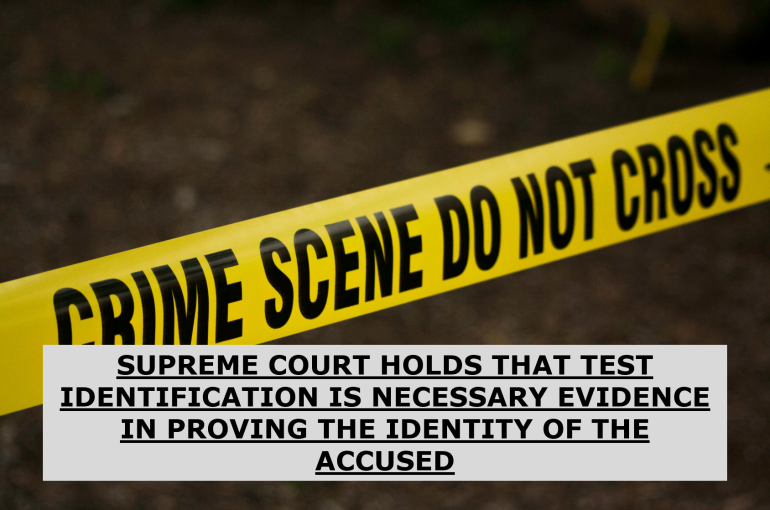SUPREME COURT HOLDS THAT TEST IDENTIFICATION IS NECESSARY EVIDENCE IN PROVING THE IDENTITY OF THE ACCUSED
A two Judge Bench of the Supreme Court comprising of Justice Sudhanshu Dhulia and Justice Prasanna B. Varale passed a judgement dated 08.07.2024 in P. Sasikumar v. The State rep. by the Inspector of Police Criminal Appeal No.1473 Of 2024 wherein the Hon’ble Court held that Test Identification Parade (TIP) is essential for a reliable identification of the Accused.
Facts
A 14 year-old girl was brutally murdered inside her house on the evening of 13.11.2014 by two accused namely Yugadhithan (Accused No. 1) and P. Sasikumar (Accused No. 2/Appellant). The father of the girl- Durairaj (PW-1) when returning home, saw his daughter covered in blood and also saw Accused No. 1 coming down the stairs wearing a helmet. Meanwhile a neighbour (PW-5) told Durairaj that he saw two men entering his home, one wearing a helmet and the other wearing a green monkey cap.
On 15.11.2014, both the accused were Apprehended by the Police and recoveries were made based on the Accused’s statements, including weapons, clothes, and vehicles. The Accused No. 1 and 2 were charged and convicted by the Trial Court under Section 302 (Punishment for murder) read with Sections 449 (House-trespass in order to commit offence punishable with death), 404 (Dishonest misappropriation of property possessed by deceased person at the time of his death), 201 (Causing disappearance of evidence of offence, or giving false information, to screen offender) and 34 (Acts done by several persons in furtherance of common intention) of the Indian Penal Code 1860 (IPC).
An Appeal was filed by the Accused No. 2 in the Madras High Court challenging the conviction wherein the High Court upheld the decision passed by the Trial Court that convicted the Accused No.2. The Prosecution’s case was largely based on circumstantial evidence, as there were no direct eye-witnesses to the murder. The conviction was mainly done on the statements provided by the PW-1 and PW-5.
The Accused No.2 (Appellant) aggrieved by the Order dated 12.01.2017 of the High Court of Madras filed an Appeal in the Supreme Court claiming that the PW-1 and PW-5 have not seen the Appellant by face as he was wearing a monkey cap. Further, the Test Identification Parade (TIP) was not conducted by the Police. Hence, the evidence provided by the prosecution was not enough to prove the identity of the Appellant.
Issues
I) Whether proper Test Identification Parade (TIP) was conducted by the Police?
II) Whether the testimonies of PW-1 and PW-5 were sufficient to convict the Appellant?
Decision by the Supreme Court
The Hon’ble Court held that it was an admitted position that the PW-5 identified the Accused No. 1 and 2 in the hospital after their arrest. On the other hand, from the investigation reports, the Hon’ble Supreme Court could conclude that the Test Identification Parade was not conducted. Moreover, there is no reasonable justification given by the Prosecution, as to why the TIP was not conducted.
The Hon’ble Bench considered the fact that the Accused No.2 was wearing a monkey cap which covers the entire face leaving only eyes and nose exposed making it difficult for a person to rightly see and identify a person. Moreover, the Accused No. 1 and 2 were complete strangers to the PW 1 and 5.
The Supreme Court held that the High Court of Madras had completely gone wrong in believing the testimony of the PW-5 was sufficient for the identification of the Appellant.
The Bench further provided that not conducting a TIP was a fatal flaw in the police investigation and thus the dock identification by the PW-5 will always remain doubtful. Further, the Bench held that the benefit of the doubt always belongs to the Accused and the Prosecution has failed to prove the identity of the Appellant beyond a reasonable doubt.
The emphasis of TIP in a given case is of vital importance as has been shown by the Supreme Court in recent case of Jayan v. State of Kerala (2021) 20 SCC 38 wherein the Bench held that-
18 “It is well settled that TI parade is a part of investigation and it is not a substantive evidence. The question of holding TI parade arises when the accused is not known to the witness earlier. The identification by a witness of the accused in the Court who has for the first time seen the accused in the incident of offence is a weak piece of evidence especially when there is a large time gap between the date of the incident and the date of recording of his evidence. In such a case, TI parade may make the identification of the accused by the witness before the Court trustworthy….”
Conclusion
The Apex Court held that the identity of the Appellant was in doubt due to the lack of concrete evidence and thus the Appellant cannot be convicted on the basis of a doubtful evidence as to Appellant’s identity. Hence, the Criminal Appeal No.1473 of 2024 was allowed and the High Court Order dated 12.01.2017 was set aside. The Hon’ble Court further ordered to release the Appellant from jail who has been suffering inside for the past 8 years. Moreover, the Hon’ble Court clarified that the decision pertains solely to Sasikumar (Appellant) and does not affect the case against Yugadhithan (Accused No.1), who did not appeal his conviction.
ARJAV JAIN
ASSOCIATE
THE INDIAN LAWYER & ALLIED SERVICES





































Leave a Reply